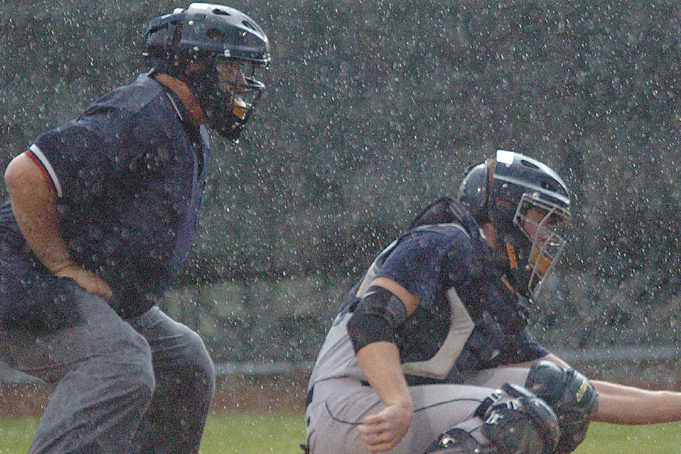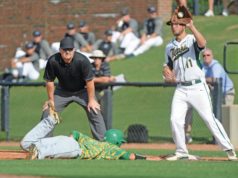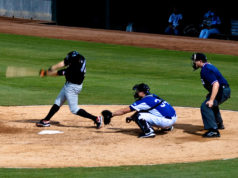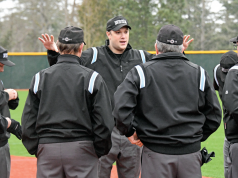When to stop a game because of darkness or weather are among the toughest calls of an umpire’s career. Next to those, you might think ball/strike and safe/out are pieces of cake. With weather and darkness, it will never be an exact science. But what follows are a few guidelines that have helped the author, Jon Bible, in his career.
The main issue is player safety. One team may pressure you to keep a game going because it is concerned about its win-loss record, but you can’t be, especially today, when everyone is at risk of being sued if a game continued longer than it should have and someone gets hurt.
A couple seasons ago, the University of Texas wanted to play although it was misting and 31 degrees with ice storm warnings. There was pressure from the Longhorn TV Network. After trying to convince a game administrator that the game should be postponed — it’s an all-turf field, so I could see players smashing into outfield walls on the slick surface — I said that if need be I’d take the lineup cards and cancel the game, as I once did in pro ball. Thankfully, he relented. I knew the university might be mad, but I didn’t care. Had it been a grass field, we would have played, as teams up north do regularly in cold and wet weather.
Most umpires work on non-turf fields with poor (or no) ground crews. If, on game day, you think weather may be a factor, do some homework. Go online and check the hourly forecast. What are the rain (or snow) chances? Is it supposed to be light or a cloudburst? If storms are predicted, when? What do you know about the ability of the field to hold and drain water? Are tarps available, and if so, who will move them? In sum, don’t just waltz in unprepared; think of what-ifs beforehand.
If the question is whether to start in a drizzle, I’d get the two coaches together and try to talk them into a delay. But it is the home team’s call, and sometimes we can’t delay because of travel issues and the like. Once we start, we have to play on unless there is a monsoon or it gets so that players start slipping around. Of course, the decision then is in our hands, unless per league policy it has been put in someone else’s. A downpour might settle the matter, but I’ve had games where, when the rain stopped, there was pressure to resume although parts of the field were a swamp.
I, again, sought mutual agreement. If everyone wanted to go home, great. If they agreed to play, I was inclined that way, but player safety might override their mutual consent. I first focused on conditions on the mound and batter’s boxes, then the infield and finally the outfield. The biggest risk is pitchers pulling a muscle, or worse, a more serious injury from slipping while striding. Batters faced a similar risk of injury when they rush out of the box. On occasion I had a pitcher take the mound and do a test stride; if he couldn’t get a firm footing, case closed.
Steady, light drizzle is a nightmare. Again, homework may help. Is drying agent available? Is someone there to spread it? Are rakes on hand? That can help you decide how long to keep things going. If so, use them liberally but then focus on the factors in the previous paragraph. And use common sense. Once an umpire at UT kept a game going in drizzle from the second inning, only to end it after the seventh after UT had scored four runs to take the lead. The visitors were homicidal. Having gone that long, I think I would have continued with more drying agent for at least another half inning.
We can more easily plan for darkness than bad weather. If I’m going to work on a field with no lights, I’ll confirm sunset time. Then I’ll factor in clouds, hills and anything else that might obscure the sun sooner than usual. My main concern is when outfielders can’t follow the ball off the bat and batters can’t see the ball out of the pitcher’s hand — in particular, a fastball coming at their head.
It gets risky at about 15 minutes before sunset, earlier if it’s cloudy. So if I know that sunset is at 6:25 p.m., I can work backward. I don’t want to start an inning if I can’t expect to finish it. In calculating, which team is ahead, by how much, and how fast the game has been played, will be minor factors.
Assume that an inning ends at 5:55 with the home team up by four. I play on because I figure we should only have to play the top half of the next inning; why not give the visitors another at-bat? But they score five runs and take 12 minutes to do so. It’s now eight minutes before sunset and I’m facing a dilemma. Do we try to finish even though we are already near risk of injury or give up so the score reverts to the last inning? What should have gone through my mind at 5:55 was that we have about 15 minutes to safely complete the next inning; if the visitors don’t follow the script and we have to go to the bottom of the inning, we can’t reasonably expect to finish. So why start?
Obviously I can’t cover every variation on this theme. For example, the inning ended at 5:49 or the score was different. My point is to look ahead and do some reasonable planning, keeping in mind: 1) never risk safety, 2) never assume things will go as expected, and 3) consider the what-ifs that may come into play if you continue. Not only do visitors unexpectedly score, but games that have been whipping along may slow to a snail’s pace. And involve the base umpire(s), as he or she will be a better judge of what the outfielders can see.
To carry the anticipation theme further, if the inning that ended at 5:55 started at 5:30, I should recognize that the odds of finishing it plus another one aren’t good, so I’ll huddle up the coaches and tell them that, barring a miracle like a six-pitch inning, this inning is it. Then there is less grumbling when I do pull the plug.
If a less-experienced umpire has the plate, you may need to step in. Once I worked with a young umpire who eventually was assigned to the College World Series. He was the plate umpire, but I let the game go to the ninth inning against my better judgment. In near darkness and with outfielders misplaying fly balls, the home team scored four in the bottom of the inning to win, whereupon all hell broke loose. Going home I learned that he wanted my help but was afraid to ask. In hindsight, I should have approached him after the seventh inning and begun the what-ifs, most likely recommending that we tell everyone that the eighth inning would be it.
Under the best circumstances, weather and darkness are challenging calls. But if we do some homework before the game and planning during it, and keeping safety uppermost in mind, we have a better chance of emerging unscathed than if we just deal with things when they confront us.
What's Your Call? Leave a Comment:
Note: This article is archival in nature. Rules, interpretations, mechanics, philosophies and other information may or may not be correct for the current year.
This article is the copyright of ©Referee Enterprises, Inc., and may not be republished in whole or in part online, in print or in any capacity without expressed written permission from Referee. The article is made available for educational use by individuals.


















